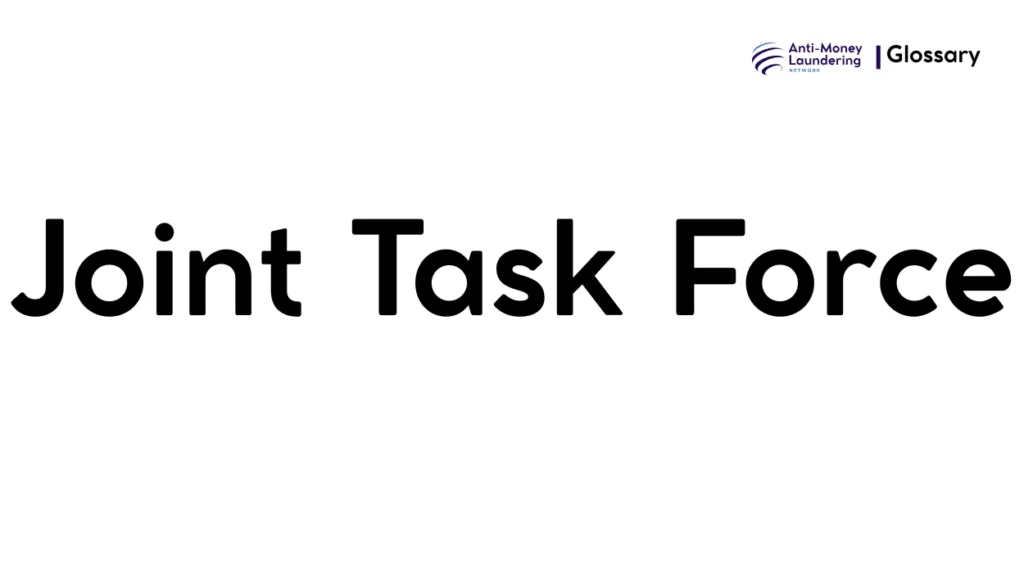Definition
A Joint Task Force in Anti-Money Laundering (AML) is a collaborative, multi-agency group formed to enhance the detection, investigation, and prevention of money laundering and related financial crimes. This task force typically includes representatives from law enforcement, financial regulatory bodies, financial institutions, customs, and other relevant stakeholders. The objective is to share intelligence, pool resources, and coordinate actions to combat money laundering more effectively than individual agencies acting alone.
Purpose and Regulatory Basis
The purpose of a Joint Task Force in AML is to strengthen efforts against financial crimes that threaten the integrity of financial systems and economies. These task forces operate under the framework of international and national AML regulations and recommendations. Key influences include:
- The Financial Action Task Force (FATF) recommendations, which urge member countries to empower investigative bodies and foster cooperation among stakeholders.
- National laws such as the USA PATRIOT Act, which mandates collaboration between financial institutions and government agencies to combat money laundering and terrorist financing.
- The European Union Anti-Money Laundering Directives (AMLD), which promote enhanced cooperation and joint action among member states.
These regulations recognize that money laundering is a complex, cross-jurisdictional crime necessitating cooperative enforcement mechanisms like joint task forces.
When and How it Applies
Joint Task Forces apply in scenarios where money laundering activities span multiple sectors or jurisdictions, requiring coordinated action. Typical triggers include:
- Suspicious transaction patterns detected by financial institutions that require law enforcement investigation.
- Intelligence sharing among banks, regulatory authorities, and law enforcement to identify organized crime involvement.
- Cases where terrorist financing or predicate offenses are suspected, demanding immediate multi-agency intervention.
Real-world examples include the UK’s Joint Money Laundering Intelligence Taskforce (JMLIT), which brings together major banks, the National Crime Agency (NCA), and other agencies to share financial intelligence and disrupt illicit financial flows.
Types or Variants
There are variations of Joint Task Forces depending on the jurisdiction and focus:
- Public-Private Partnerships (PPP): These involve cooperation between government agencies and private sector financial institutions, e.g., JMLIT in the UK.
- Government-Only Task Forces: Composed solely of law enforcement, customs, and regulatory bodies, focused on criminal investigation and prosecution.
- Specialized Financial Investigation Units: Some countries have dedicated financial enforcement agencies operating as an AML Joint Task Force, such as India’s Directorate of Enforcement and Financial Intelligence Unit.
Procedures and Implementation
To comply and participate effectively in a Joint Task Force, financial institutions and other stakeholders typically follow several structured procedures:
- Establish secure channels for confidential sharing of suspicious activity reports (SARs) and intelligence.
- Implement internal AML systems capable of identifying and reporting suspicious transactions that may warrant referral to the task force.
- Engage in regular training and coordination meetings to align on typologies, emerging risks, and investigative priorities.
- Use technology platforms for real-time data analytics and information exchange.
- Coordinate action plans for investigation, asset freezing, or prosecution based on task force intelligence.
Impact on Customers/Clients
From a customer’s perspective, involvement of a Joint Task Force may lead to:
- Increased scrutiny on transactions, especially unusual or high-risk activities.
- Possible delays in transaction processing due to enhanced due diligence or investigations.
- Restrictions or freezing of accounts if linked to suspicious or criminal activity.
- Protecting legitimate customers by reinforcing the financial system’s integrity, which benefits all clients in maintaining trust and security.
Duration, Review, and Resolution
Joint Task Forces are typically ongoing bodies with regular review mechanisms to assess effectiveness and adapt to emerging threats. The duration of specific investigations or actions triggered by the task force varies widely depending on case complexity. Members have continuing obligations to update and report new intelligence, ensuring that enforcement actions stay relevant and timely.
Reporting and Compliance Duties
Institutions involved in Joint Task Forces carry significant compliance responsibilities:
- Timely reporting of suspicious activities to designated task force contacts or national financial intelligence units.
- Maintaining detailed records to support investigations and potential prosecutions.
- Adherence to legal frameworks governing privacy, data protection, and information sharing.
- Subject to audits and penalties for failures to comply with AML regulations or task force protocols.
Related AML Terms
The Joint Task Force concept intersects with several AML terms:
- Financial Intelligence Unit (FIU): Central national agency collecting and analyzing financial data, often integral to task forces.
- Suspicious Activity Report (SAR): Documented alerts that task forces use to identify potential laundering.
- Know Your Customer (KYC) and Customer Due Diligence (CDD): Processes that feed initial data points for task force investigations.
- Predicate Offenses: Underlying crimes generating illicit funds targeted by these task forces.
Challenges and Best Practices
Common challenges faced by Joint Task Forces include:
- Legal and operational barriers to cross-agency and cross-border cooperation.
- Data privacy concerns limiting information sharing.
- Resource constraints and the need for sophisticated analytical tools.
- Balancing proactive intelligence sharing with confidentiality and compliance.
Best practices emphasize:
- Clear memoranda of understanding (MOUs) defining roles, responsibilities, and protocols.
- Investment in shared technology platforms for secure data exchange.
- Ongoing training to keep pace with evolving money laundering methods.
- Building strong relationships between public and private stakeholders to foster trust and collaboration.
Recent Developments
Recent trends in AML Joint Task Forces include:
- Increasing use of advanced analytics and artificial intelligence to detect complex laundering schemes.
- Expansion of task force membership to include more diverse financial institutions and sectors.
- Greater focus on combating emerging threats such as trade-based money laundering and proliferation financing.
- Strengthening of regulatory frameworks globally to mandate joint task force participation and enhance sanctions enforcement.
A Joint Task Force in Anti-Money Laundering is a critical collaborative mechanism that enhances the detection, investigation, and prevention of complex financial crimes. Rooted in international and national regulatory frameworks, it brings together diverse stakeholders to share intelligence and coordinate action. By combining resources and expertise, joint task forces significantly improve the effectiveness of AML efforts, safeguarding financial systems and economies worldwide.

